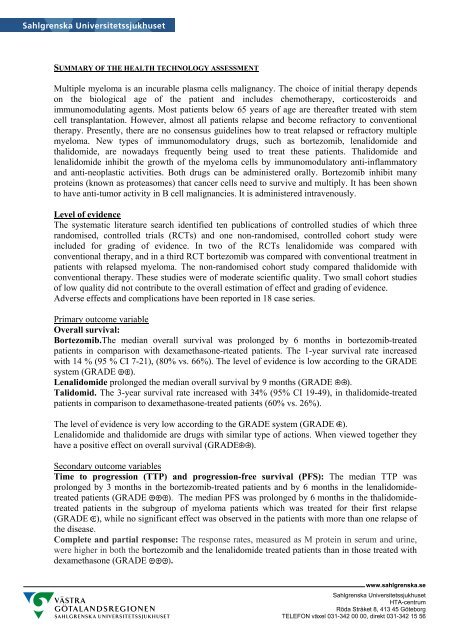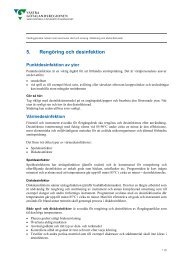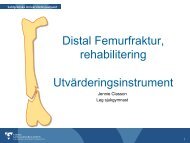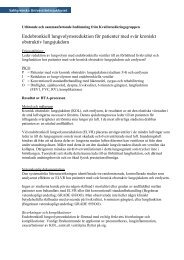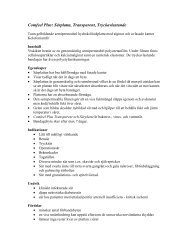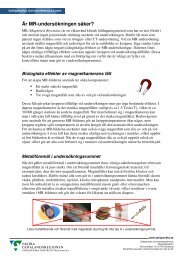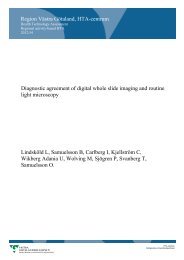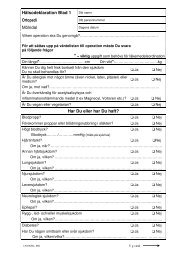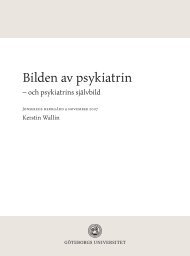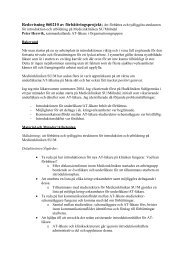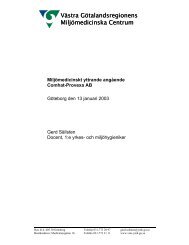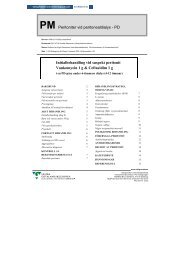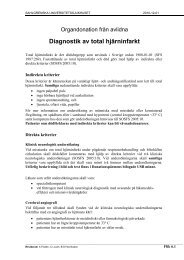Läkemedelsbehandling vid relaps av myelom - Sahlgrenska ...
Läkemedelsbehandling vid relaps av myelom - Sahlgrenska ...
Läkemedelsbehandling vid relaps av myelom - Sahlgrenska ...
You also want an ePaper? Increase the reach of your titles
YUMPU automatically turns print PDFs into web optimized ePapers that Google loves.
SUMMARY OF THE HEALTH TECHNOLOGY ASSESSMENT<br />
Multiple <strong>myelom</strong>a is an incurable plasma cells malignancy. The choice of initial therapy depends<br />
on the biological age of the patient and includes chemotherapy, corticosteroids and<br />
immunomodulating agents. Most patients below 65 years of age are thereafter treated with stem<br />
cell transplantation. However, almost all patients <strong>relaps</strong>e and become refractory to conventional<br />
therapy. Presently, there are no consensus guidelines how to treat <strong>relaps</strong>ed or refractory multiple<br />
<strong>myelom</strong>a. New types of immunomodulatory drugs, such as bortezomib, lenalidomide and<br />
thalidomide, are nowadays frequently being used to treat these patients. Thalidomide and<br />
lenalidomide inhibit the growth of the <strong>myelom</strong>a cells by immunomodulatory anti-inflammatory<br />
and anti-neoplastic activities. Both drugs can be administered orally. Bortezomib inhibit many<br />
proteins (known as proteasomes) that cancer cells need to survive and multiply. It has been shown<br />
to h<strong>av</strong>e anti-tumor activity in B cell malignancies. It is administered intr<strong>av</strong>enously.<br />
Level of e<strong>vid</strong>ence<br />
The systematic literature search identified ten publications of controlled studies of which three<br />
randomised, controlled trials (RCTs) and one non-randomised, controlled cohort study were<br />
included for grading of e<strong>vid</strong>ence. In two of the RCTs lenalidomide was compared with<br />
conventional therapy, and in a third RCT bortezomib was compared with conventional treatment in<br />
patients with <strong>relaps</strong>ed <strong>myelom</strong>a. The non-randomised cohort study compared thalidomide with<br />
conventional therapy. These studies were of moderate scientific quality. Two small cohort studies<br />
of low quality did not contribute to the overall estimation of effect and grading of e<strong>vid</strong>ence.<br />
Adverse effects and complications h<strong>av</strong>e been reported in 18 case series.<br />
Primary outcome variable<br />
Overall survival:<br />
Bortezomib.The median overall survival was prolonged by 6 months in bortezomib-treated<br />
patients in comparison with dexamethasone-rteated patients. The 1-year survival rate increased<br />
with 14 % (95 % CI 7-21), (80% vs. 66%). The level of e<strong>vid</strong>ence is low according to the GRADE<br />
system (GRADE ).<br />
Lenalidomide prolonged the median overall survival by 9 months (GRADE ).<br />
Talidomid. The 3-year survival rate increased with 34% (95% CI 19-49), in thalidomide-treated<br />
patients in comparison to dexamethasone-treated patients (60% vs. 26%).<br />
The level of e<strong>vid</strong>ence is very low according to the GRADE system (GRADE ).<br />
Lenalidomide and thalidomide are drugs with similar type of actions. When viewed together they<br />
h<strong>av</strong>e a positive effect on overall survival (GRADE ).<br />
Secondary outcome variables<br />
Time to progression (TTP) and progression-free survival (PFS): The median TTP was<br />
prolonged by 3 months in the bortezomib-treated patients and by 6 months in the lenalidomidetreated<br />
patients (GRADE ). The median PFS was prolonged by 6 months in the thalidomidetreated<br />
patients in the subgroup of <strong>myelom</strong>a patients which was treated for their first <strong>relaps</strong>e<br />
(GRADE ), while no significant effect was observed in the patients with more than one <strong>relaps</strong>e of<br />
the disease.<br />
Complete and partial response: The response rates, measured as M protein in serum and urine,<br />
were higher in both the bortezomib and the lenalidomide treated patients than in those treated with<br />
dexamethasone (GRADE ).<br />
www.sahlgrenska.se<br />
<strong>Sahlgrenska</strong> Universitetssjukhuset<br />
HTA-centrum<br />
Röda Stråket 8, 413 45 Göteborg<br />
TELEFON växel 031-342 00 00, direkt 031-342 15 56


